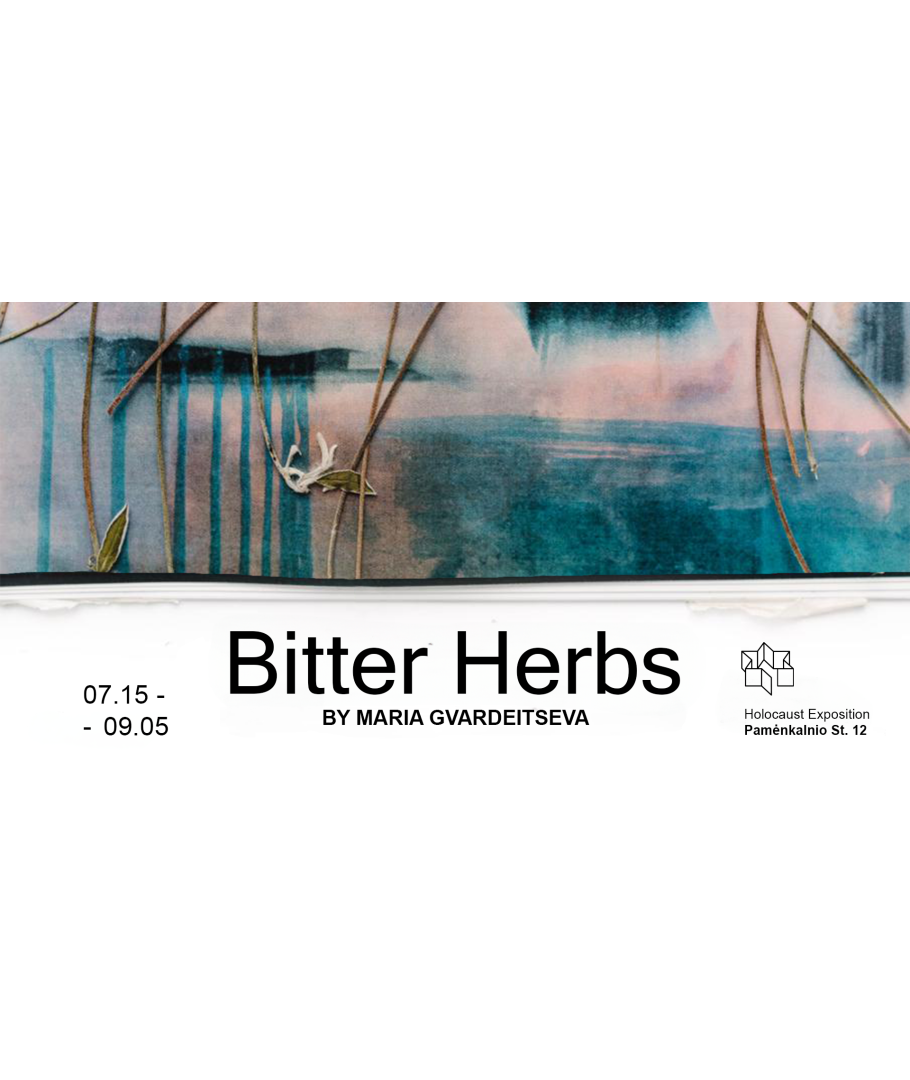Karčiosios žolelės (Bitter Herbs) - Maria Gvardeitseva
- Titulinis
- Parodos ir renginiai
- Renginiai
- Karčiosios žolelės (Bitter Herbs) - Maria Gvardeitseva

(english text bellow)
Nuo liepos 15 d. iki rugsėjo 5 d. Holokausto ekspozicijoje veiks Marijos Gvardeycevos paroda „Karčiosios žolelės“ Atmintis, kurios negalima nutylėti.
Šiandien tylus miškas, žolynais apaugusi laukymė ar samanomis dengtą žemę slepiantis šlaitas vakar buvo neįsivaizduojamo smurto vieta. Lietuvoje, Latvijoje ir Baltarusijoje Holokausto masinių kapaviečių vietos pamažu susiliejo su gamta. Nors kai kurios pažymėtos atminimo ženklais, dauguma atrodo taikios, lyg užmirštos. Tačiau tai - tik paviršius.
Maria Gvardeitseva parodoje Karčiosios žolelės siūlo pažvelgti į šias vietas kaip į gyvus atminimo ženklus. Miškai ir žolės čia tampa nebyliais liudytojais, tyliais atminties saugotojais.
Nuo 2022-ųjų menininkė pradėjo rinkti žoleles ir augalus iš Holokausto vietų Lietuvoje ir Latvijoje. Į Baltarusiją grįžti negalėjusi dėl politinio persekiojimo, ji pasitelkė draugus - šie siuntė jai džiovintus augalus, įspaustus tarp senų fotografijos žurnalų puslapių. Atsivėrus šiems žurnalams, augalai tarsi atgyja; per jų formas ir tekstūras išryškėja netikėtos vizualinės jungtys su archyviniais vaizdais.
Taip gimsta Žolelių atlasai (Herbal Atlases) - koliažai, kuriuose augalų siluetai susilieja su nuotraukose matomais Antrojo pasaulinio karo kareiviais, levituojančiomis moterimis, kūdikiais ar jaunikėmis. Kartais - su vos įžiūrimais, bet kraupiai prasmingais figūrų kontūrais.
Parodoje pristatomi koliažai, fotografijos su augalais ir žmogaus plaukais bei vaizdo instaliacija By the Wayside Stands a Tree. Filmuota dronu virš nežymėtų kapaviečių, ji perteikia tylos, judesio ir vėjo kalbą. Vienintelis garso takelis - jidiš lopšinė „Oyfn veg shteyt a boym“, dainuojama Efimo Chorny. Tai lopšinė apie išėjimą, ilgesį ir meilę - tarsi atsisveikinimas, kuriam vis dar priešinamės.
Karčiosios žolelės - tai kvietimas atpažinti trapias, bet gyvas šaknis to, ką istorija dažnai bando užkasti. Tai atminties patirtis, kuri kyla ne iš vadovėlių, bet iš lapo gyslos, popieriaus grūdėtumo, sidabro žybsnio fotografijoje.
Parodą kuravo Maya Katznelson
(EN)
From July 15 to September 5, the Holocaust exhibition will feature Marija Gvardeyceva’s exhibition "Bitter Herbs" A memory that cannot be silenced.
What is today a quiet forest, a meadow overgrown with grass, or a slope covered in moss-covered ground, was yesterday a site of unimaginable violence. In Lithuania, Latvia, and Belarus, Holocaust mass grave sites have gradually merged with nature. Although some are marked with memorial signs, most appear peaceful, as if forgotten. But that is only the surface. In her exhibition Bitter Herbs, Maria Gvardeitseva invites us to view these places as living memorials. Forests and grasses become silent witnesses, quiet keepers of memory.
Since 2022, the artist has been collecting herbs and plants from Holocaust sites in Lithuania and Latvia. Unable to return to Belarus due to political persecution, she enlisted the help of friends who sent her dried plants pressed between the pages of old photography magazines. When these magazines are opened, the plants seem to come alive; through their shapes and textures, unexpected visual connections emerge with archival images.
The exhibition Bitter Herbs brings together three interconnected bodies of work. A series of large-scale wall pieces incorporates dried plants gathered from Holocaust memorial sites in Belarus, Lithuania, and Latvia. These are mixed with strands of natural human hair and sealed under layers of latex that carry the printed pigmentation of real human skin — a material technique developed by the artist. Each frame corresponds to a specific site of mass killing, with the plants forming a botanical atlas of that place.
The second medium emerged unexpectedly during the research process: magazines sent from Belarus, containing pressed plants, began to “speak” through visual encounters with printed images — soldiers, women, and newborns. These Herbal Atlases became collages in their own right. The third element of the exhibition is a two-channel video, By the Wayside Stands a Tree, filmed entirely with drones over unmarked mass graves. Wind, forests, and grasses become the only visible witnesses. The soundtrack is a Yiddish lullaby, Oyfn veg shteyt a boym, sung by Efim Chorny — a song of parting, tenderness, and fragile care.
Bitter Herbs is an invitation to recognize the fragile yet living roots of what history often tries to bury. It is an experience of memory that arises not from textbooks, but from the vein of a leaf, the grain of paper, the flash of silver in a photograph.
Curated by Maya Katznelson